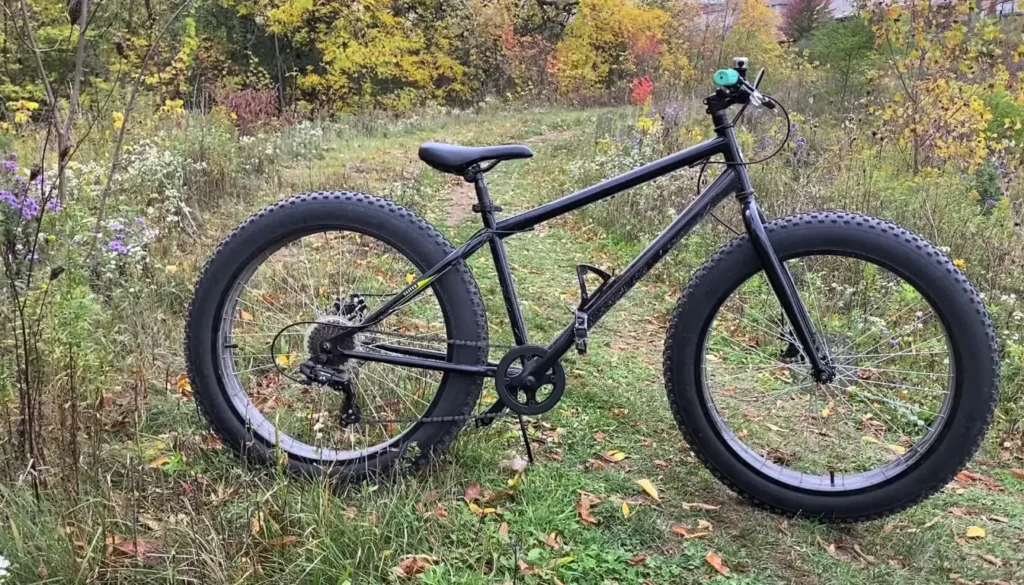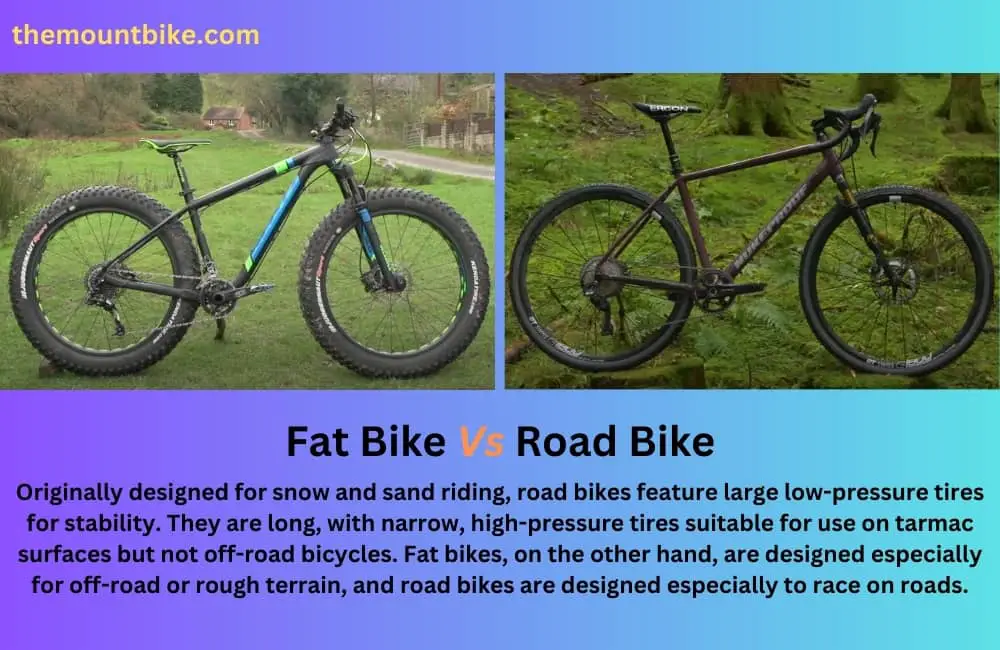Nowadays, riding bikes has become much more popular on the roadside or even while climbing hills. But we become perplexed when choosing the right bike for us. As a result, “fat bike vs road bike” becomes the contradictory part since we found both types of bikes in the professional cyclists’ picks.
Generally, a fat bike is an off-road bicycle with extended wide tires. Since the tires are wider and thicker, they offer less speed but have more traction. But road bikes with narrow tires are great for extra speed. On the other hand, road bikes cannot handle tough terrain during rainy and cold weather, whereas fat bikes are ideal on the roadside or on trails.
Today’s article is a proper guideline and a comparison round between road bikes and fat bikes. After completing this article, you’ll be able to choose the better-performing two-wheeler bicycle.
Fat Bike Vs Road Bike: Advantages and Disadvantages
In general, your riding preferences and needs will determine the bike’s usability. But how would riding a fat-tired bike or a narrow-tired bike over soft rock roads compare in terms of ride and effort? Do we know what exactly fat bikes and road bikes are constructed for? Let us help you understand the difference and capacity of both bicycles.
What Do We Consider A Fat Bike?
Many people lack knowledge regarding fat bikes when they are just starting out cycling. Basically, the fat bike, often referred to as the wide-tire snow bike, is an off-roadside bicycle constructed to perform on low ground stress to let the rider ride on soft, challenging terrain such as snow, mud, sand, and bogs. The general tire size we will find is 3.8″ (97 mm) or even more. Plus, the rims will be 2.16″.
What Do We Consider A Road Bike?
For riding on a paved surface rather than rough terrain, road bikes are an accurate pick. We often seek extra speed on empty roads to ride like horses, and you can achieve a good pace by paddling your road bike. So, road bikes will be the obvious choice for city residents due to their streamlined design and improved aerodynamics. Plus, road bikes can run under great pressure, typically around 100 PSI.
Are Fat Bikes Good On The Road?
Yes, it’s theoretically true that you can enjoy your ride on both roads and trails with the fat bike, and you’ll also get extra traction. Yet cycling on mud or snow doesn’t offer the same performance advantages.
But you need a fat bike if you prefer to enjoy the natural beauty of the area, or you may travel by bicycle. Also, it would be much preferable to ride a skinny tire bicycle to navigate through the mud or on any tough terrain.
Are Fat Bikes Good For Long Distance?

Undoubtedly, you’ll be able to ride the fat bike for a long time with extra comfort on any surface. Those who want to exercise or go on lengthy trips can also choose the fat bikes. Even you can burn up to a thousand calories each hour.
People often ask, “Are fat-tire bikes good on the pavement?” Fat-tire bikes are suitable for all types of terrain, particularly paved areas. This feature is the biggest selling point. Even so, the bike will be excellent for touring because of its MTB-style extra-wide tires.
Are Road Bikes Good For Long Distance?
Road bikes are ideal for traveling long distances, and an 80-kilometer daily commute on a decent hybrid is manageable. Most road bikes can’t handle big loads, and they’re not appropriate for touring. Additionally, off-road grounds make it difficult for cyclists who have road bikes with narrow tires.
See Also: Convert road bike to hybrid
How Far Can You Ride on a Fat Bike?
Let’s say you ride an MTB or a gravel-specialized fat bike. To be a little bit safer on the pavement, you’ve even installed road tires. But how far can it go without compromising safety?
If you are intending to go cycling in any challenging snow terrain or among jammed sand, such bikes can perform admirably for 1,000 kilometers. But, going on too long a tour is not advisable.
How Far Can You Ride On A Road Bike?
Distances longer than 20 miles with a road bike will make you feel uncomfortable. However, a road bike cyclist can often cover 55 to 60 kilometers daily. In order to understand the distance capability, you should count 40,000 kilometers (25,000 miles) as the total distance a road bike can go.
Is It Harder To Pedal A Fat Tire Bike? 5 Common Facts
No, pedaling a big-tire bike is not challenging. Instead, they are simpler to pedal across any type of road surface, such as snow, sand, mud, rocks, hills, and anywhere else. But in case of tire contact and friction with your ground, fat tire bikes become a little bit tougher to pedal when moving. For the cyclist, we have some facts based on pedaling with a fat bike.
- Whether it’s the sand, beach, or any snowy ground, big-tired fat bikes can handle any type of terrain.
- During the summertime or in the winter, fat bikes will be beneficial for traveling on roads.
- Overweight people can find it challenging to pedal.
- Sometimes, a fat tire bike seems awkward while pedaling.
- Also, a fat bike is much easier to ride since it’s large and has weight-distributing wheels.
Is A Road Bike Hard To Ride?
No, riding a road bike will give you speed and a simple cycling experience on paved surfaces. Indeed, it’s possible that the handling of the bicycle is a little bit different than all the conventional bikes out there.
A road bike will be shaky and unstable when riding compared to a mountain or fat bike. Therefore, you’ll need to have controlling ability. Also, they are quicker than elliptical trainers on wheels, skates, reclining bicycles, scooters, or even red wagons.
Advantages of Fat Bikes
Fat bikes have different beneficial facts, whether distance, comfort, or perhaps some other benefits. However, let’s explore all the positive facts about fat-tire bikes.
- The wide tires give you more traction and grip when matched with low tire pressure.
- Compared to normal bicycles, traveling in any terrain, like snow or sand, with a fat tire is much more agreeable.
- Fat bikes are best for accurate off-road riding and roaming!
- Such a bike is much more flexible and simpler to handle since it has big, fat tires, which can help you ride on the surface rather than in the air.
- For better versatility, make sure you pick the fat-tire bike.
- Fat bikes are amazing for exercise and even better for building muscle.
- The bikes’ strong frames make them much more durable and able to sustain heavy use.
Disadvantages of Fat Bike
It’s not necessary to be perfect from every angle! So, the fat bike should have some flaws, negative points, or disadvantages. However, let’s see what points we should be careful of when we have a fat tire bike.
- A decent fat bike requires a significant investment, which means it is expensive.
- Such bikes move a little bit slower.
- If any of the bike parts get damaged, replacement becomes troublesome as fat tire bike parts are not always available.
- Extra weight due to wide tires is a nuisance!
- Frequently, it’s more difficult to steer a bike with fat tires on any technical ground.
- Almost all the power comes from muscles.
- There is a possibility of knee or hip injuries.
See Also: Can you put fat tires on any bike
Advantages of Road Bike
It’s not like fat bikes are always better. On the other hand, we have road bikes, which are convenient for other purposes. So, let’s see when we should pick the road bike and how the bike received positive feedback from the cyclist.
- Road bikes are available at an affordable price.
- For outstanding speed, road bikes are amazing!
- You’ll notice ergonomic design goes into the road bike.
- Road bikes are lightweight, have different hand positions, and are aerodynamic.
- Climbing hills becomes simple with road bikes or mountain bikes, and you can even quickly twist through tight or crowded corners when riding on a busy street.
- You will also get cardio benefits from using the bike.
- Use your road bike for the commute when you have a lengthy cycling plan. Even on the weekend, you can ride 50 miles on this type of bike.
Disadvantages Of Road Bike

The road bike is good for speed, but compared to the fat bike, you’ll find some problems with a road bike. Let’s see the cons of road bikes or the type of bikes we consider mountain bikes.
- The road bike is unsuitable for navigating rough terrain or obstacles like roots, rocks, etc.
- The strength of a lighter frame is lower than that of an off-road or traveling frame.
- On uneven terrain, lightweight wheels cause serious damage.
- Simple maneuvers like accelerating or braking will be challenging since they provide less traction.
- Riding in traffic is quite risky and might be impacted by the drop bar’s existence.
- The beginner will have difficulty riding the narrow-tired roadside bike.
- Even road bikes are quite expensive, and their parts are not always available.
Fat Bike Versus Road Bike: Tire Size Comparison
When you compare the tire diameters of a fat bike and a road bike, you’ll see that the fat bike tires have a larger diameter, measuring 26″ to 27.5″. The rims usually have a width of 50 to 100 mm or 3.8″ to 5.2″. Additionally, the size of the front hubs is around 135 to 170mm, whereas the rear hub spacing is 170 to 190mm.
In contrast, most road bikes’ outside diameter is 700 mm, where the width starts at 23mm. You’ll find the rear wheel hubs can be 120, 126, or 130 mm wide, and 100 mm wide in the front hub. However, you can look at the chart to distinguish between fat wheels and road bike wheels.
| Types of Bike | Fat Bikes | Road Bike |
| Width of Tire | 100 to 127mm | 23 to 29mm |
| Tire Pressure | 5 to 15 PSI | 80 to 130 psi |
| Weight Capacity | 200 pounds (Each Tire) | 110 to 175 |
Speed Comparison: Between Fat Bike Versus Road Bike
Fat-wheel bikes, which have fatter tires, are heavier, and have additional traction, will be slower than road bikes. Bars, an upright design, and tires bigger than 2″ are all features of this bike, so slow movement is quite normal for this type of bike. Also, as a daily commuter, you’ll need to expend energy to move with the bike.
The road bikes offer outstanding riding speed on paved surfaces, which is possible because they have narrower tires and a lightweight design. You can even ride at a good pace without feeling any body pressure. Say thanks to the drop bars and racy geometry, which will ensure more speedy performance!
Riding on Different Terrains: An Experience Among Fat and Road Bicycles
Road bikes are mostly made for smooth ground. Basically, these bikes are good for the occasional off-road tour. Even individuals ride such bikes for regular commuting. Additionally, riding a road bike will make you feel bumpier due to improper stabilization. However, office goers can be comfortable with road bikes.
On the other hand, fat bikes are a gift for taking pleasure in the journey on various mountain trails. Although the road bike may not provide the same level of comfort, the increased traction will make it appropriate while roaming on snowy or muddy ground. We highly recommend riding fat-wheel bikes for trekking, hiking, and traveling.
See Also: What happens when you ride a bicycle every day
Pedaling Comfort: Between Fat Bike And Road Bike
Don’t you prefer effortless pedaling? Road bikes will make pedaling easier due to their lightweight style, thin tires, and reduced traction. And there will be no stress while riding!
Fat bikes require slightly harder pedaling than road bikes. This is because of the thick tires and additional traction. Hence, more stress and fatigue will occur!
Maintenance And Pricing: Difference Between Fat Bike And Road Bike
Do we know which bike will be much more affordable, the road bike and the fat bike? Compared to road bikes, fat-tire bicycles are significantly more expensive. The cost of a fat bike can range from $250 to $500. On the other hand, a road bike can be under $5000 when it’s premium, and the regular type of bike is usually around $250.
Regardless of the type of bike you ride, whether it has broad or narrow tires, you must always maintain it and keep it secure from damage. If you don’t use the bike for a long period of time, it will eventually become damaged, corroded, or need to be repaired. Thus, ensure you check the bikes’ condition and enjoy your rides with them frequently.
FAQs
To understand which bicycle you should pick, fat and road bikes can be more specified with information if you check the Q&A section. We have the frequently asked questions that will help you better understand the two-wheeler differences.
1. Are fat bikes harder to ride?
No, riding a fat bike is considerably simpler on sand, mud, snow, hills, or any other kind of ground. A fat bike might lessen the amount of stress on your body since it has large wheels. Also, such kinds of bikes give the riders more traction.
2. Is a fat bike better than normal bike?
Genuinely, fat-wheel bikes make it easier to ride on challenging terrain, which is difficult with normal bicycles. Fat tires offer extra traction and easy riding, which is better than a normal bike.
3. Fat bike vs MTB which is better?
A fat-wheel bicycle requires more effort than a mountain bicycle. According to our site, both bike types have different purposes, so you should pick the one that is comfortable for you. Usually, fat tire bikes are 3.8 to 5.2 inches wide, whereas mountain bikes can be between 1.9 and 2.6 inches wide.
4. Can a fat bike go uphill?
Yes, you can ride your fat bike uphill. As the bike has large tires and extra traction, it will climb ideally.
5. How much weight can fat tire bikes hold?
The typical weight restriction for bicycle tires is between 100 and 400 pounds. Also, the majority of the weight limit is 300 lbs., and it can exceed 400 lbs.
See Also: Fat bike vs Mountain bike
Wrapping Up
Have you understood the distinctions between a fat bike and a road bike? In short, a fat bike is basically made of fat tires that offer increased traction, good controllability, and, most importantly, the ability to travel through any tough terrain. Road bikes will have thin tires and less stabilization but offer excellent navigation speed.
However, if you ever want to decide on the best bike for riding, check the pros and cons of a fat and road bike. If you’re riding for an office job, the road bike is good, but if you’re riding for traveling or hiking, go with the fatter one.

